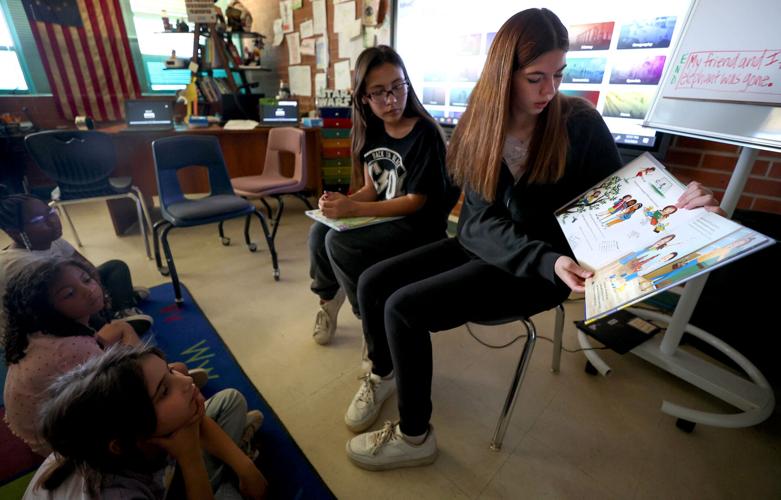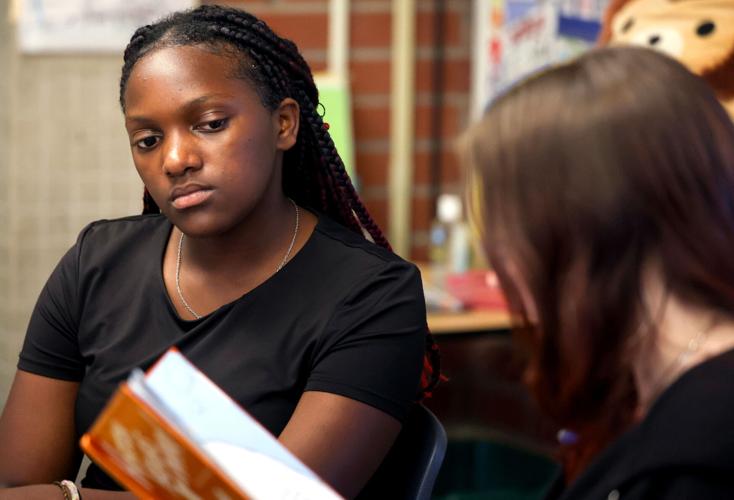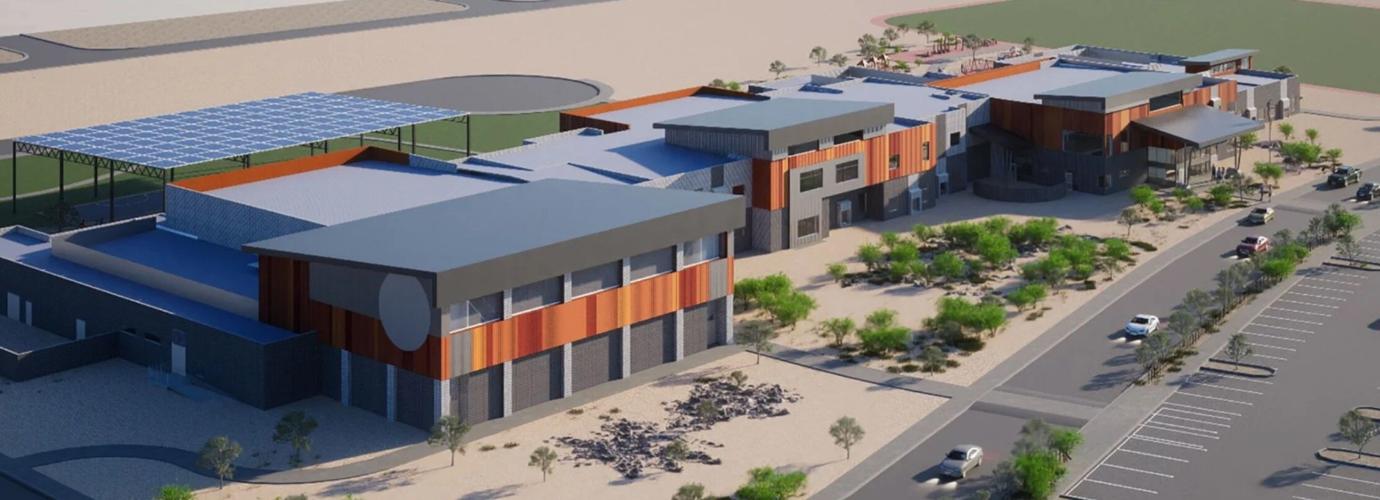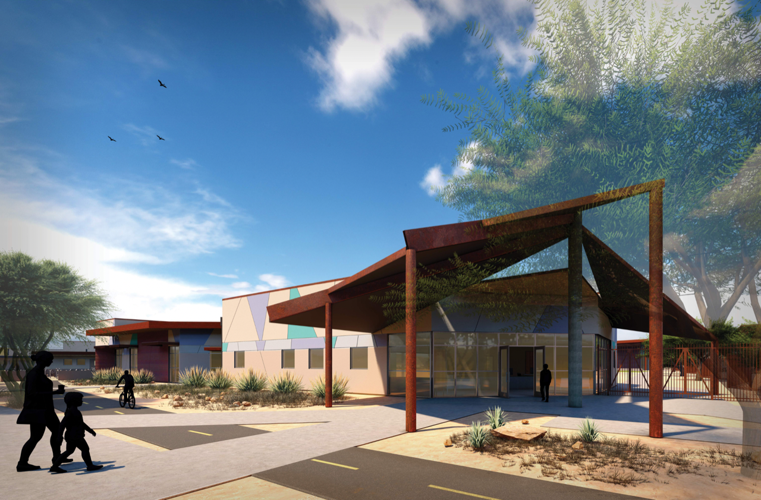It’s another busy Thursday at Dietz K-8 school as elder Dietz students read to the school’s younger students.
Students in Dietz’s government class become student teachers for 45 minutes, twice a week.
“They are able to read to the entire class, or read to a small group of students while the teacher works with other small groups on comprehension, phonics, and other stuff,” said Principal Jesus Vasquez, said of the Tucson Unified School District campus.
“It becomes like a Big Brother-Big Sister program,” Vasquez explained.
Similar scenarios are being anticipated by families, faculty in Marana and Vail school districts, where each has a K-8 school being built for the 2025 school year.
Vail and Marana each already have established K-8 campuses.
TUSD has more than a dozen K-8 schools up and running, including Dietz.
Marana K-8 ‘conceived out of necessity’

The preliminary design for Marana’s upcoming K-8 school. A groundbreaking is scheduled for mid-May. The campus will host up to 800 students.
In north Marana, the district’s budding K-8 school was conceived out of necessity, as two nearby elementary schools are bursting at the seams. And a traditional middle school nearby is at capacity, said Marana Superintendent Dan Streeter.
Like most K-8 schools, the older students will be kept separate from the younger ones.
“We had to add portable buildings at Gladden Farms (K-6) to accommodate some of the overcrowding,” Streeter said. “There is definitely a need. You have the growth in the area and we knew that with the development that’s going on, there was a need in this area for another elementary school.”
Having one campus to accommodate multiple schools-worth of overflow makes good economic sense, Streeter explained.
“From an economic standpoint, by doing a K-8, you’re kind of getting a two for one — obviously a little bit more square footage than what you would have done for either one.”
The bond issue blessed by Marana USD voters in November was developed to help fund the district’s new K-8, totaling $40 million. It was a community effort to decide on establishing another K-8 school, Streeter said.
“Regarding the decision about doing a K-8, it was about our governing board, it was about our senior staff administration, and it was … our was really the bond committee, because that’s where the money came from,” he said. “That bond committee consisted of community members and parents. They were all a part of this conversation.”
Groundbreaking for Vail’s K-8

A rendering of Vail Unified School District’s K-8 school, which broke ground last week.
Vail celebrated the groundbreaking Thursday of its latest addition — Saguaro Creek K-8. The school, located at 8150 S. Rocking K Ranch Loop, will serve students preschool through eighth grade. Phase one of the two-phase project opens in 2025, hosting students grades kindergarten through seventh. Phase one is estimated to cost $32 million.
It will be under the leadership of current VUSD Ocotillo Ridge Elementary School principal Kate Robold.
Heather Blumhardt is a member of a VUSD K-8 project committee consisting of community members, including parents like herself. Blumhardt said a K-8 school was on Vail’s wish list from the get-go.
Blumhardt said at first, a K-5 looked more plausible, but with the future in mind, leaders determined it was important to make a K-8 happen.
“There’s absolutely a need in our area,” she said. “Just with the number of potential homes at Rocking K and the other communities surrounding it.”
Making the move towards K-8 was about having options for families, said John Carruth, VUSD superintendent.
“The first and most important reason that we have K-8 is that we believe really strongly in parental choice. And we believe really strongly that one type of school or one model of school doesn’t fit the needs of all children. And so that’s fundamentally that’s what drives our decisions around what kinds of schools to offer.”
Simplified logistics for families with multiple students are a plus, Blumhardt, a parent of five children, said. She said her second-grader will attend third grade at Saguaro Creek and will be within walking or biking distance to Saguaro Creek K-8.
“It’s not uncommon (for students) to spend an hour on the bus. We live less than five miles from the school.”
Families with multiple kids often have transportation needs at multiple schools. A school housing a larger span of grades cuts down on those pick-ups and drop-offs, Blumhardt said.
Concerns about older kids mingling with young kids shouldn’t be an issue, Blumhardt said. “There will be physical separation. They operate on a completely different schedule, as far as how they rotate classes. So, no, it’s, it’s not concerning to me.”
Blumhardt also mentioned she’d heard about some K-8 schools facilitating mentoring opportunities for older and younger students.
“I’ve heard some folks talk about how it gives the older kids an opportunity to lead and foster the younger ones.”
TUSD’s Dietz: ‘We grow our own students’
Vasquez has led school models besides K-8, like Dietz, including high school and middle school.
Dietz — and other K-8 schools — are unique, he said. “One of the biggest things is you build the connection right off the bat. Next year, we’re going to be in PreK-8. That’s going to be awesome, because we grow our own students, we have no feeders.”
Vasquez said his southeast Tucson campus has markedly better teacher retention.
“We did a culture and climate survey last year; we scored about 94 … 95. One of the things that I’m also proud of is our teacher turnover rate. We don’t lose a lot of teachers — we lost teachers to retirement or because they’re moving out of the state.
“Are they leaving because they don’t like what’s going on at Dietz? No.”
Vasquez also said he has found student discipline issues easier to address at his K-8 school because the students are part of the Dietz community for a longer term.
“It’s easy for us to identify the situation, try to prevent it because we know our kids,” Vasquez said. “We’ve had them for three, four years, so we know exactly what’s going to trigger a student.”
Academically, K-8 schools can get the short end of the stick, particularly considering Arizona Department of Education (ADE) state grades. The state education department uses letter grades as an accountability model for school performance.
“It’s a tough question,” said Streeter, MUSD’s superintendent. “What I will say is the way that Arizona (Department of Education) does their student accountability system 7-8 models, it becomes very difficult for them to perform well. That doesn’t mean that learning isn’t happening or achievement isn’t happening. It’s just the way the model is built.”
“It’s a challenge,” Dietz’s principal said. “For example, on my side if I was a K-5, my K-5 is very strong. They’re the foundation I have.”
Often, middle school-aged students are going through significant academic transitions, making state test achievement difficult, Vasquez added.
In K-8 schools, if one level scores lower in achievement, the entire school’s letter grade suffers.
In school year 2022-23, the state Department of Education graded Dietz as a C school.
Streeter said, “If you have a cohort of students that is typically struggling academically, 7 and 8 middle school, that’s 50% of your population. In a K-8 setting, that’s one-ninth of your population. That’s a big difference.”
But state grades for individual schools aren’t something Blumhardt frets about. The Vail parent advises fellow parents to look at the big picture — if at all — when it comes to ADE grades.
Some things can’t be quantified, Vasquez pointed out.
“I remember last year, I would walk into my kindergarten class. Some of those kids were identical. I said, ‘Hey, you’re Johnny’s little brother, who’s a sixth-grader.’ That was great. Building that family relationship, it’s crucial. You get to know the students as they get older.
“You build that trust.”







